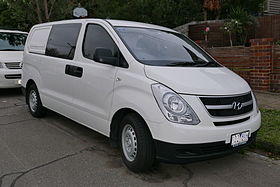Hyundai Starex
| Hyundai Starex | |
|---|---|
 |
|
| Overview | |
| Manufacturer | Hyundai Motor Company |
| Production | 1997–present |
| Assembly | South Korea: Ulsan Egypt: Cairo (Ghabbour Group) Indonesia: Bekasi Malaysia (Hyundai Malaysia) Turkey: Izmit |
| Body and chassis | |
| Body style | 4-door van |
| Chronology | |
| Predecessor | Hyundai Grace |
| First generation (A1) | |
|---|---|
 |
|
| Overview | |
| Also called | Hyundai H-1 Hyundai H200 Hyundai Libero (truck) Hyundai Satellite JAC Refine |
| Production | 1997–2007 2002–present (China) |
| Body and chassis | |
| Layout | FR layout |
| Related |
Mitsubishi Delica Hyundai Porter |
| Powertrain | |
| Engine | 2.4 L Sirius I4 petrol 2.5 L D I4 diesel 2.5 L TD I4 diesel 2.5 L CRDI VGT I4 diesel 3.0 L DOHC V6 (LPG) |
| Dimensions | |
| Wheelbase | RV Wagon/Van: 2,810 mm (110.6 in) Jumbo Wagon/Van: 3,080 mm (121.3 in) |
| Second generation (TQ) | |
|---|---|
 |
|
| Overview | |
| Also called | Hyundai Grand Starex Hyundai Starex Royale Hyundai i800 Hyundai H-1 Hyundai H-1 Travel Hyundai H-1 Cargo Hyundai iLoad Hyundai iMax Hyundai H300 Huatai-Hyundai H1 Cargo Huatai-Hyundai H1 Van Ram H100 Van/Wagon (Mexico) |
| Production | 2007–present |
| Layout | FR layout |
| Powertrain | |
| Engine | 2.4 L Theta II I4 MPi petrol 2.5 L TCi I4 diesel 2.5 L CRDI VGT I4 diesel 2.5 L CRDI WGT diesel |
| Transmission | 4-speed automatic 5-speed automatic 5-speed manual 6-speed manual (From 2012) |
| Dimensions | |
| Wheelbase | 3,200 mm (126.0 in) |
| Length | 5,125 mm (201.8 in) |
| Width | 1,920 mm (75.6 in) |
| Height | 1,925 mm (75.8 in) (Wagon) 1,935 mm (76.2 in) |
The Hyundai Starex is a van built by the Hyundai Motor Company in South Korea and Indonesia since 1997.
First generation models were known in Europe as the Hyundai H-1 and as the Hyundai H200 in the Netherlands. For the second generation, Australian and UK market models are sold as the Hyundai iLoad (cargo version), in Australia as Hyundai iMax and the UK as Hyundai i800 (people mover versions). European models are differentiated as the Hyundai H-1 Cargo (cargo version) and Hyundai H-1 Travel (people mover version). In the Netherlands, it is called Hyundai H300 with the people mover version of the H300 is for fleet only.
The Starex succeeded the Hyundai Grace (also known as the H100) in most countries. Like the Hyundai Grace, the first generation A1-series Starex was based on the Mitsubishi Delica and was available in a wide range of configurations, including minivan (MPV), minibus, van, pick-up, taxi, and ambulance. For the very first 1997 models, it used the Mitsubishi derived 2.5-liter 4D56 SOHC 8-valve non-turbo diesel engine with 55 kW (74 hp) and 142 N·m (105 lb·ft) at 2,500 rpm. These first generation models were initially restricted for sale to the domestic South Korean market, but were eventually exported to a number of countries in Southeast Asia and some parts of Europe.
For the 1998 model year, a gasoline engine was offered, a Mitsubishi derived 4G64 108 kW (145 hp) at 5,250 rpm with 218 N·m (161 lb·ft) of torque at 4,000 rpm. The diesel engine now comes with a slightly more powerful Mitsubishi derived 4D56 non-intercooled turbo diesel engine with 62 kW (83 hp) at 201 N·m (148 lb·ft) at 2,000 rpm. Available in two trim levels, SVX and Club, and a number of body styles (commercial panel van, and pick up (Libero)). A long wheelbase (12-seater) "Jumbo" and short wheelbase (seven- and nine-seater) "RV" was also available. First introduced to this model are luxurious features like side lower body cladding with two-tone paint scheme (SVX, Club), optional dual sunroof (Club), side body "Tetris style" decals (Club), chrome slant grills, rear tailgate handle opener cover (Club), cream moquette upholstery (Club), optional high-tech head unit with television screen and six-disc CD changer (Club) for domestic models, power windows and antenna (SVX, Club) an Aisin Seiki Co. sourced four-speed automatic transmission with ECT and overdrive switch and differently styled "star" 15-inch alloy wheels with exposed lug nuts (Club). For safety, it also features limited-slip differential (LSD), anti-lock braking system (ABS) and driver side airbag. This models was exported to a number countries and proved a big hit to some car markets like the Philippines where at that time was imported via gray market. It gained instant popularity for comfortable sedan-like drive, availability of automatic transmission, expansive interior space and thickly bolstered seats. Its main advantage was being priced lower than its twin, the Mitsubishi Delica Space Gear, yet it packed more features and factory accessories like front bull bars, top basket loader, and a rear ladder. For the following year in the Philippines, the gasoline engine version was dropped due to unusually high gasoline consumption, but still made available for other markets.
...
Wikipedia
